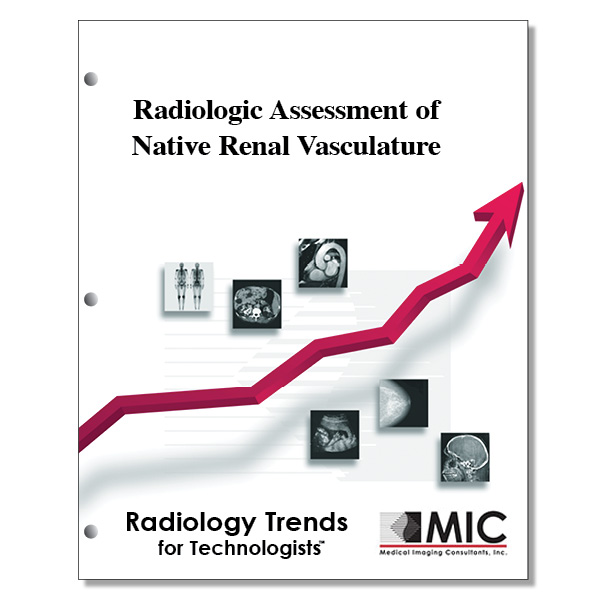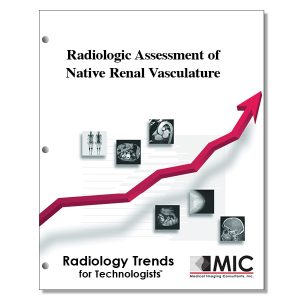

Radiologic Assessment of Native Renal Vasculature
A multi-modality radiologic assessment of native renal vasculature.
Course ID: Q00530 Category: Radiology Trends for Technologists Modalities: CT, MRI, Sonography, Vascular Interventional3.5 |
Satisfaction Guarantee |
$37.00
- Targeted CE
- Outline
- Objectives
Targeted CE per ARRT’s Discipline, Category, and Subcategory classification for enrollments starting after January 30, 2024:
[Note: Discipline-specific Targeted CE credits may be less than the total Category A credits approved for this course.]
Computed Tomography: 2.00
Procedures: 2.00
Abdomen and Pelvis: 2.00
Magnetic Resonance Imaging: 2.00
Procedures: 2.00
Body: 2.00
Registered Radiologist Assistant: 3.50
Procedures: 3.50
Abdominal Section: 3.50
Sonography: 2.00
Procedures: 2.00
Abdomen: 2.00
Vascular-Interventional Radiography: 2.00
Procedures: 2.00
Vascular Diagnostic Procedures: 1.00
Vascular Interventional Procedures: 1.00
Vascular Sonography: 2.00
Procedures: 2.00
Abdominal/Pelvic Vasculature: 2.00
Outline
- Introduction
- Anatomy
- Imaging Protocols
- Processes Affecting the Renal Arteries
- Renal Artery Stenosis
- Fibromuscular Dysplasia
- Renal Artery Entrapment
- Renal Artery Dissection
- Renal Artery Aneurysm
- Pseudoaneurysm
- Mycotic RAA
- Renal Artery Occlusion
- Systemic Disorders Affecting the Renal Arteries
- Polyarteritis Nodosa
- Other Vasculitides
- Neurofibromatosis
- Takayasu Arteritis
- Arteriovenous Communications
- Arteriovenous Malformation
- Arteriovenous Fistula
- Arteriovenous Connections Associated with Renal Cell Carcinoma
- Secondary Ureteropelvic Junciton Obstruction Caused by Crossing Vessels
- Processes Affecting the Renal Veins
- Nutcracker Syndrome
- Renal Vein Thrombosis
- Renal Vein Tumor Thrombosis
- Renal Cell Carcinoma
- Other Tumors
- Renal Vein Leiomyosarcoma
- Renal Vein Traume
- Conclusion
Objectives
Upon completion of this course, students will:
- state the length and diameter of the main renal artery
- name the only major vessel to course posterior to the inferior vena cava
- list the origins for multiple renal arteries in patients with horseshoe kidney
- list the veins that drain the kidney
- choose the imaging modality that provides real-time qualitative and quantitative information regarding the renal vasculature
- select the peak systolic velocity range in the main renal artery
- list advantages of CT for evaluation of renal vasculature
- state the most common cause of secondary hypertension
- describe where direct signs of renal artery stenosis appear
- express the percent of accuracy of CT angiography for the diagnosis of renal artery stenosis
- list the secondary CT signs of hemodynamically significant stenosis
- state the renal resistive index suggesting poor therapeutic response to revascularization treatment of renal artery stenosis
- describe the arteries affected by fibromuscular dysplasia
- list the subclassifcations of fibromuscular dysplasia
- associate medial fibroplasia with “string of pearls” appearance
- state the imaging procedure that is 100% sensitive for the diagnos
- is of fibromuscular dysplasia
- choose the treatment of choice for renal artery stenosis caused by fibromuscular dysplasia
- list the non-specific symptoms of renal artery dissection
- describe where spontaneous artery dissection most often originates
- differentiate between treatment methods for spontaneous renal artery dissection
- state the most common site for renal artery aneurysm
- state additional arteries that may be affected in patients with renal artery aneurysm
- choose the surveillance time frame for renal artery aneurysms 1.0-1.5 cm in diameter
- list treatments for renal artery aneurysms
- state the symptoms of pseudoaneurysm
- choose the imaging modality the shows the “yin-yang” sign
- list inflammatory changes associated with mycotic renal artery aneurysm
- express the time frame in which main renal artery occlusion can lead to kidney infarction
- state the shape of renal infarction as seen on contrast-enhanced CT
- state the imaging reference standard for detection of renal artery occlusion
- express the artery sizes affected by polyarteritis nodosa
- select the most common cause of death in NF-1 patients
- choose the patient population in which NF-1 associated stenoses often occur
- list the manifestations associated with Takayasu arteritis
- state the classification for renal AVMs
- tell the percentage of arteriovenous fistulas that occur after renal biopsy
- choose the best imaging procedure to define ureteropelvic junction obstruction
- describe nutcracker syndrome
- choose the imaging examination of choice for the diagnosis of nutcracker syndrome
- list the risk factors for renal vein thrombosis
- state the most common type of cancer to affect the renal veins
- state the most common renal and abdominal malignancy of childhood
- choose the muscle source of leiomyosarcoma
- state the percent to which injury to the renal vein occurs as a rare complication of abdominal trauma
